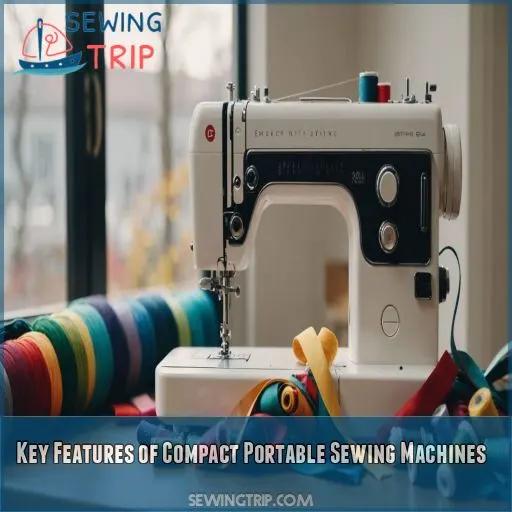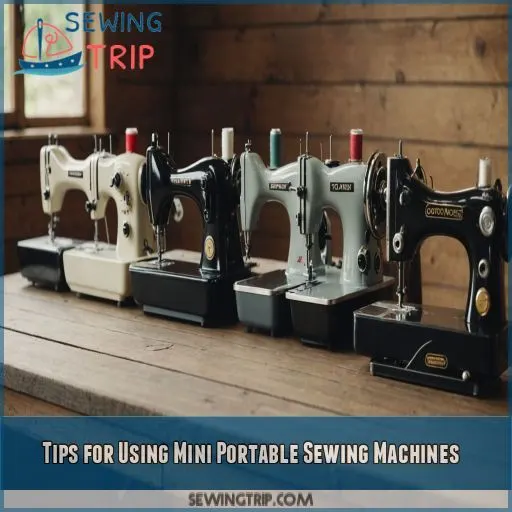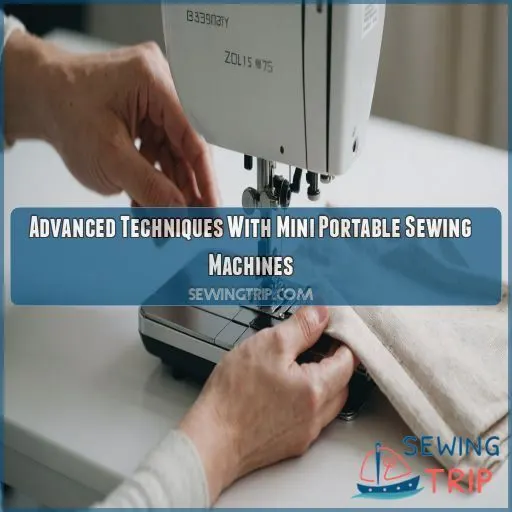This site is supported by our readers. We may earn a commission, at no cost to you, if you purchase through links.
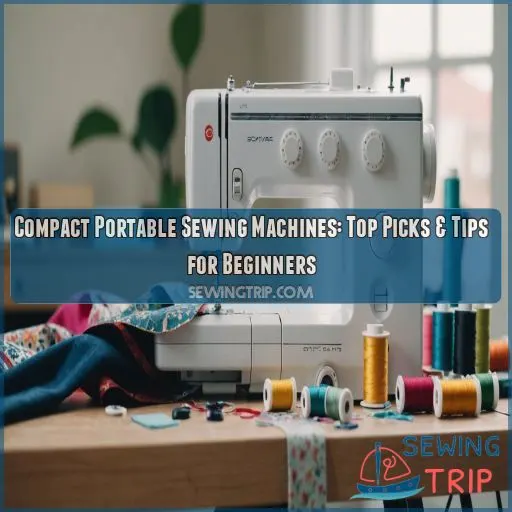
Whether you’re a beginner looking to mend clothes or an experienced sewist craving creative control, these mini marvels have you covered.
From featherlight models perfect for travel to heavy-duty machines that tackle thick fabrics, there’s a compact companion for every sewing need.
Explore a world of adjustable speeds, automatic threading, and decorative stitches – all in a portable package.
With the right compact sewing machine, you’ll be stitching up a storm anytime, anywhere.
Get ready to tap into your sewing superpowers!
Table Of Contents
Key Takeaways
- With compact sewing machines, you can sew on-the-go without missing out on power. These little devices are like Swiss Army knives of sewing, packed with fun features like automatic threading and decorative stitches to spice up your projects anywhere, anytime.
- Picking the right portable sewing machine is like choosing a pet. From lightweight models perfect for travel to heavy-duty options that tackle denim, consider size, weight, features, and material durability to find your ideal stitching companion.
- Sewing’s not just about straight lines; it’s about creative control. Handy extras like LED lights, adjustable speeds, and free arms make projects – from pesky hems to creative embroidery – a piece of cake.
- Even the most seasoned sewist can hit a snag, so maintain your machine with regular cleaning and keep it snug as a bug in a protective case. Remember: a well-loved machine is a happy one, ready for whatever sewing shenanigans you dream up next!
Choosing the Best Mini Sewing Machine
When you’re hunting for the best mini sewing machine, it can feel like choosing a pet at the pet store—each type has its own quirks and charms! You’ll want to think about the size and weight, materials, and whether its features match your skill level and stitching needs.
Standard Vs. Handheld Machines
When choosing the best mini sewing machine, you’ll find two main types: standard and handheld. Standard models offer more features and capabilities, while handheld machines prioritize portability and convenience. Consider your sewing needs, skill level, and budget to determine which style best suits your requirements for storage, portability, and ease-of-use.
Considerations for Size and Weight
When picking your compact sewing machine, size and weight matter more than you’d think. You want a small sewing machine that’s a breeze for travel and tiny on storage but mighty on projects. With a lightweight sewing machine in your toolkit, you’ll be sewing like a pro in any space, even if it’s just the corner of your couch!
Material Options and Durability
So, you’re pondering materials. Plastic vs. metal could sound like the opening salvo of a boxing match! Plastic offers portability, but metal? It screams durability. If you’re planning long-term projects, go for heftier material to make sure your sewing machine lasts. The right choice impacts performance dramatically. Weave durability into your selection process for the best mini sewing machine experience.
Matching Skill Level to Machine Features
When choosing a sewing machine, match its features to your skill level. Like Goldilocks, you don’t want too basic or too advanced—it’s gotta be just right! A beginner-friendly electric sewing machine offers simplicity, while enthusiasts may crave advanced stitch options in a multi-functional model. Make sure the machine complexity suits your projects for satisfying sewing sessions.
Stitching Options and Capabilities
Think of mini sewing machines like a Swiss Army knife for stitch enthusiasts.
They offer a range of stitch types, from straight to zigzag, covering most sewing adventures.
Many mini sewing machines also offer decorative stitches and free-motion embroidery for a fancy touch.
You can adjust the stitch length and width to suit your project.
The reverse stitch keeps things intact, and the button sew-on feature saves the day when mischievous buttons go rogue!
Additional Features to Consider
You’re almost at the finish line in choosing your sewing powerhouse. Consider these features for greater freedom and control:
- LED Light: Illuminate your workspace like a pro.
- Thread Cutter: Slice through threads without hassle.
- Cuff Slot: Sew sleeves with ease.
- Adjustable Speed: Tame the fabric beast at your pace.
Key Features of Compact Portable Sewing Machines
You’ll love how compact portable sewing machines fit into any small space, making them perfect for quick stitch-ups and projects on the go. They come packed with features like adjustable speed and stitch options, automatic needle threading, and more, making them your new best friend in tackling sewing tasks with ease and a touch of flair.
Portable Design and Compact Size
When you’re on-the-go, these space-saving marvels are like the Swiss Army knives of sewing—compact and always ready! A portable design enables freedom in tailoring adventures everywhere. Plus, they fit snugly in small spaces or a neat carrying bag with a foot pedal tucked alongside.
| Feature | Benefit |
|---|---|
| Compact Design | Easy Storage |
| Lightweight | Travel Ready |
| Foot Pedal | Precision |
Keep sewing dreams tightly packed!
Adjustable Speed and Stitch Options
With compact portable sewing machines, speed control and stitch variety spice up your projects. Picture yourself adjusting the sewing speed like a maestro conducting an orchestra, finding the perfect tempo. These machines offer a buffet of stitch options—vary the stitch length and width to suit your creative whims. Stitching becomes an art form, empowering you to master every thread.
Automatic Needle Threading and Buttonhole Sewing
You’ve mastered adjustable speeds, now let the sewing machine do a little of the heavy lifting with automatic needle threading—saving you from the crossed-eyed struggle. As for buttonholes, use the right buttonhole foot types and you’ll button up faster than you can say ‘sewing machine parts.’ Different fabrics? No sweat! Just let the machine work its magic.
LED Lighting and Workspace Height
A sewing machine’s LED brightness melts visibility issues, making every stitch as clear as day.
Like butter on a hot biscuit, task lighting is a game changer if you’re attempting intricate patterns or sewing under moonlight.
Workspace size gives you ample room to maneuver, making your sewing comfortable.
Your masterpiece’s destiny lies not just in skill, but in workspace support.
Sew away!
Free Arm and Presser Foot Options
Get more out of your sewing with a free arm, perfect for tight spots like cuffs or hems. Dance through projects with interchangeable presser feet! From zigzag to zipper, these sewing accessories make sewing as easy as pie. Discover compatible sewing machine attachments for various techniques, expanding your creative horizons. It’s the ultimate toolkit for mastering sewing projects effortlessly!
Top 7 Mini Portable Sewing Machines
When you’re on the hunt for the perfect mini portable sewing machine, there’s an array of options designed to fit your specific sewing needs and experience level. Whether it’s the ever-reliable Brother XM2701 or the beginner-friendly Singer Start 1304, each choice makes sure that crafting and repair jobs are a stitch in time, saving you both hassle and money.
1. Brother XM2701 Sewing Machine
The Brother XM2701 sewing machine is your go-to tool for seamless creativity. With 27 built-in stitches, including zigzag and decorative options, it’s versatile for any project. Its automatic needle threader and drop-in bobbin make setup a breezeperfect for those who love to be in control. While it hums like a bee (not the quietest), its free arm feature is great for cuffs. Though not a lightning bolt with brightness, the sturdy support system makes sure you’re never sewing solo. Get started with mastery using the Brother XM2701!
Best For: The Brother XM2701 sewing machine is best for beginners and those looking for a versatile, easy-to-use machine with a variety of stitches.
- It has a wide range of stitches, including decorative and quilting stitches.
- The automatic needle threader and drop-in bobbin make setup a breeze.
- It comes with a 25-year limited warranty.
- The machine can be noisy.
- The LED light is not very bright.
- Some users have reported issues with thread tension and the presser foot lever.
2. Portable Sewing Machine for Beginners
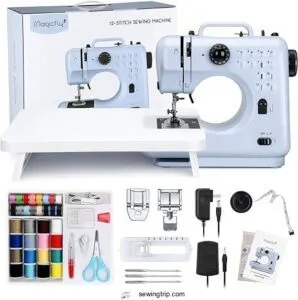
Looking for a portable sewing machine? Consider the Magicfly machine—a versatile gadget that’s got your back for those quick fixes and crafty endeavors. It’s small, easily fits into your workspace, and perfect for beginners with its user-friendly features and varied stitch options. Juggling between home projects and on-the-go mending? This machine’s lightweight nature makes it a breeze to carry. While it’s not without quirks like bobbin issues, its charm lies in simplicity and practicality, making sewing less of a chore and more of a joy.
Best For: The Magicfly sewing machine is best for beginners looking for a portable and easy-to-use machine for basic mending and simple projects.
- Lightweight and portable for easy transport and storage.
- User-friendly features with a simple design and clear instructions.
- Multiple stitch options for basic sewing needs.
- Potential for malfunctions and issues with the foot pedal, power adapter, and reverse stitch functionality.
- Frequent jamming and thread tangles can be frustrating.
- Stitch quality may be inconsistent and limited to basic stitches.
3. Portable Sewing Machine for Kids and Beginners
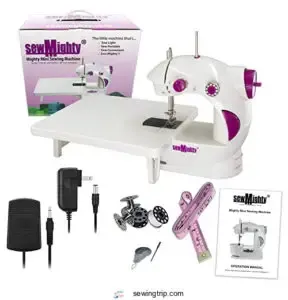
When diving into sewing as a beginner or a kid, you want a machine that’s like a trusty sidekick: small yet mighty. The Sew Mighty Mighty Mini fits this bill perfectly. It’s lightweight, easy to tote around, and packs features like an automatic bobbin winder and a two-speed motor. While it may bend a needle now and then, remember even heroes have quirks! You’ll find this machine balances portability and functionality, making it as versatile as a swiss army knife for budding sewists.
Best For: The Sew Mighty Mighty Mini is best for beginners, kids, and anyone who wants a portable sewing machine for simple projects.
- It is compact and lightweight, making it easy to transport.
- It has an automatic bobbin winder, which saves time and effort.
- It is affordable and comes with everything you need to get started.
- It only does a straight stitch and does not backstitch.
- Some users have reported issues with the thread tension and the needle bending easily.
- It is not as durable as some other sewing machines.
4. Singer Start 1304 Sewing Machine
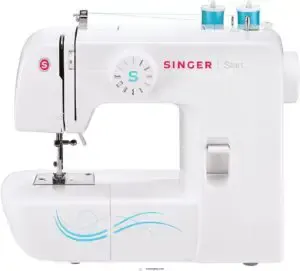
Meet the SINGER Start 1304, your reliable sewing sidekick. Weighing a mere 11.5 pounds, it’s perfect for the nomadic sewer. With 6 built-in stitches and a speed of 350-400 stitches per minute, think of it as your trusty steed; maybe not a racehorse, but steady and dependable. Automatic bobbin winding and easy threading mean stress-free sewing. Beginners, rejoice! You’ll love mastering these sewing essentials, effortlessly tackling small projects and gaining confidence. Just don’t expect it to handle upholstery—like asking a pony to plow fields!
Best For: The SINGER Start 1304 is best for beginners and those who need a lightweight, portable machine for simple sewing projects.
- Easy to use with straightforward features.
- Lightweight and portable for sewing on the go.
- Automatic bobbin winding and easy threading make it beginner-friendly.
- Limited number of stitches, not ideal for complex projects.
- Not powerful enough for heavy-duty sewing like upholstery or quilting.
- Basic features may not meet the needs of more experienced sewers.
5. Brother CS5055 Sewing Machine
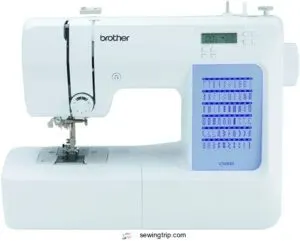
(Source) The Brother CS5055 is a versatile computerized sewing machine that’s perfect for beginners and budget-conscious sewers. With 60 built-in stitches, including 7 one-step buttonholes, this machine offers impressive functionality at an affordable price. The bright LED-lit work area and easy-to-use needle threader make sewing a breeze, while the metal frame guarantees long-lasting durability. Although it may not be suitable for heavy-duty projects, the CS5055 is an excellent choice for tackling a wide range of sewing tasks with ease. Its compact size and quiet operation make it a great companion for your sewing adventures. (Source)
Best For: The Brother CS5055 is best for beginners and budget-conscious sewers who want a versatile machine for a variety of sewing projects.
- Offers a wide range of stitches, including buttonholes, for a variety of sewing needs.
- Features an easy-to-use needle threader and bright LED-lit work area for a comfortable sewing experience.
- Its compact size and quiet operation make it ideal for home use.
- May not be suitable for heavy-duty sewing projects.
- Some users have reported difficulties threading the needle and the thread pulling out of the needle eye.
- The foot pedal may lack resolution for precise control.
6. Portable Sewing Kit for Quick Repairs
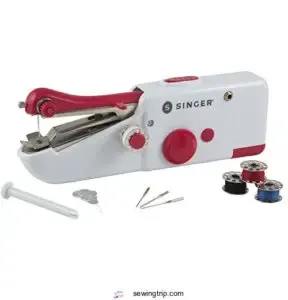
You know those times when your favorite shirt suddenly sprouts a hole at the last minute? That’s where a portable sewing kit comes to the rescue! This lightweight, handheld mending machine, perfect for quick repairs, is your trusty sidekick for minor sewing hiccups. It’s not replacing your full-sized machine, but it’s great for lightweight fabrics. Toss it in your bag for spontaneous stitches on the go. Remember, this little dynamo runs on batteries, so keep some handy for those emergency repairs!
Best For: This portable sewing kit is best for crafters, travelers, and anyone who needs to make quick repairs on lightweight fabrics.
- Lightweight and portable, perfect for taking on the go.
- Great for quick fixes and minor sewing projects.
- Includes everything you need to get started, including threads, bobbins, needles, and a thread spindle.
- May be difficult to use on stretch fabrics.
- Stitches may come undone if the instructions are not followed exactly.
- Only has one speed, which can make it challenging to use.
7. SINGER MX60 Sewing Machine
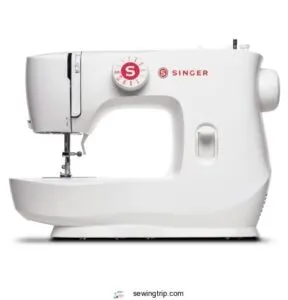
The SINGER MX60 sewing machine offers flexibility, perfect for those ready to master sewing without feeling tangled up. Lightweight and compact, it fits like a dream into small spaces or travels easily. The 57 stitch applications mean you can sew almost anything, from hemming jeans to crafting cute decor without breaking a sweat. Its user-friendly features make it easy as pie, even if threading a needle feels like threading a camel through the eye! Enjoy your freedom and jump into your next project.
Best For: The SINGER MX60 sewing machine is best for beginners and crafters who need a portable and easy-to-use machine for basic sewing projects.
- 57 stitch applications offer a variety of sewing options.
- Lightweight and compact design makes it easy to store and transport.
- User-friendly features make it simple to operate, even for beginners.
- Durability concerns due to the use of plastic components.
- Not as powerful as heavier machines, making it difficult to sew delicate fabrics.
- No physical instruction manual included, requiring reliance on online resources.
Tips for Using Mini Portable Sewing Machines
When it comes to mini portable sewing machines, picking the right fabric and mastering thread tension can make your sewing journey smoother. Don’t let common issues unravel your enthusiasm; with a bit of maintenance and proper storage, your machine will be ready for any creative adventure just like keeping your car clean for road trips, but way less gas!
Choosing the Right Fabric and Thread
When choosing fabric and thread for your mini sewing machine, consider the project’s needs. Lightweight fabrics like cotton or linen work well, while heavier materials may require a more powerful machine. Match your thread weight to the fabric – thin thread for delicates, thicker thread for sturdier pieces. Experiment to find the perfect combo for a smooth, professional finish.
- Fabric Types: Cotton, Linen, Silk, Denim, Velvet
- Thread Weights: 30, 40, 50, 60, 100
- Thread Colors: Coordinate with fabric
- Fabric Care: Pre-wash, iron, cut carefully
Threading and Tensioning the Machine
Threading your sewing machine can feel like threading a camel through a needle, but with practice, it becomes second nature.
Keep a close eye on top thread and bobbin tension.
Choose thread types wisely, as mismatches can cause headaches.
Troubleshooting issues before they unravel is key.
And remember, even seasoned sewers make common mistakes.
Don’t let thread tension tie you in knots!
Basic Sewing Techniques and Stitches
You’re ready to master those mini sewing machines! After threading the machine perfectly, let’s tackle basic techniques. Explore the straight stitch for seamless lines or the zigzag stitch to add flair. Ready to change fabric types? Use the back stitch for strength. Keep seam finishes tidy. Like baking a cake, patience is key—just don’t eat the fabric!
- Straight stitch
- Zigzag stitch
- Back stitch
- Seam finishes
Troubleshooting Common Issues
After mastering basic stitches, troubleshooting is your next adventure.
If your mini sewing machine jams, it could be a thread tension fiasco.
Skipped stitches? Check the needle – the silent hero or villain in sewing tales.
Bobbin winding woes? A common saga.
Often, sewing machine dealers offer advice.
Maintenance and Storage Tips
Keep your mini sewing machine in tip-top shape by regularly cleaning and oiling the moving parts. Store it in a protective case when not in use to prevent dust buildup. Invest in handy accessories like a short adapter shank, magnifying lens set, and extra bobbins to make the most of your compact companion.
Advanced Techniques With Mini Portable Sewing Machines
You’re ready to enhance your sewing skills with your mini portable sewing machine, tackling everything from delicate silks to sturdy denim. Break out the fancy threads and optional presser feet—it’s time to create intricate designs that’ll dazzle even your cat, lying unimpressed on your fabric stash.
Working With Delicate or Thick Fabrics
You’ve mastered basic techniques, now let’s tackle delicate or thick fabrics. Fab selection matters—choose light needles for lace, hefty ones for denim. Balance stitch tension and foot pressure like juggling eggs! Give that old walking foot or roller foot some love. Troubleshooting issues? Try using a fabric-feeding aid or thread-lubrication unit. Control those tricky seams like a seasoned pro!
Creating Decorative Stitches and Embellishments
After mastering delicate fabrics, it’s time to explore decorative stitches.
Open up your creativity with embroidery techniques like free-motion quilting.
Experiment with decorative thread and stitch combinations for unique flair.
Attachments like circular and eyelet embroidery add charm.
Play with stitch width and adjustable stippling for stylish designs.
Couching inserts provide texture.
Sewing’s an adventure, so let your imagination run wild!
Sewing Small or Intricate Projects
When sewing small or intricate projects on your mini portable sewing machine, a few tips can make all the difference.
Use an adjustable ruler to precisely measure and mark your fabric.
Invest in a ruler kit with various markings for perfect hems and seams.
Attach a straight stitch hemmer foot for clean, professional-looking edges.
Utilize a seam guide with a scale to maintain consistent stitch length.
Using Optional Presser Feet and Accessories
Get to know optional presser feet, and expand your sewing machine’s capabilities! With presser foot types like straight- and cutwork stitch plates, you can conquer tricky fabrics. For DIY enthusiasts, try punchwork plates or a plexiglass extension table. Use a right or left seam guide for precision. Store your presser-foot set with care—don’t lose those tiny treasures!
Expanding Your Sewing Skills and Creativity
Expanding your sewing skills is like opening new doors. Get into advanced techniques with mini machines, adding flair to every stitch.
- Fabric choices: Tackle everything from delicate silks to sturdy denims.
- Sewing techniques: Master difficult tasks like the invisible zipper or double cord.
- Embroidery tips: Upcycle your creations with decorative stitches.
Crafting a masterpiece? You’ve got this in the bag!
Frequently Asked Questions (FAQs)
How to maintain a mini sewing machine?
Keeping your mini sewing machine in tip-top shape is like nurturing a tiny, dependable friend. Regular cleaning, lubrication, and tension checks keep it purring happily. Remember, even machines need a little TLC to stay needle-sharp!
What are the power options for mini machines?
Mini sewing machines usually offer two power options: direct AC use and battery power. Plug into an outlet for uninterrupted sewing, or go unplugged with batteries when you’re feeling adventurous and want to sew anywhere, anytime.
Can mini machines sew multiple fabric layers?
Absolutely, mini sewing machines can handle multiple fabric layers, though it depends on the machine’s power and needle strength. Imagine them like a determined squirrel stacking nuts for winter – careful progress makes success without jamming.
Are mini machines suitable for quilting projects?
While mini machines can handle basic quilting tasks, they’re not ideal for intricate projects needing multiple layers or large quilts. They might struggle with thickness and control—like trying to juggle bowling pins with oven mitts!
How to troubleshoot sewing machine tension issues?
Tension issues? They’ll drive you bonkers! First, check your threading and tension discs. Next, adjust the tension dial slightly, test on scrap fabric, and repeat. Like tuning a guitar, finding balance is key to sewing bliss.
Conclusion
With over 20 million compact portable sewing machines sold annually, these mini marvels are a must-have for sewists of all skill levels.
Whether you’re a beginner looking to mend on the go or an experienced sewist craving creative control, a compact portable sewing machine opens up a world of sewing possibilities.
Stitch up a storm anytime, anywhere and tap into your sewing superpowers with the right compact portable sewing machine by your side.


